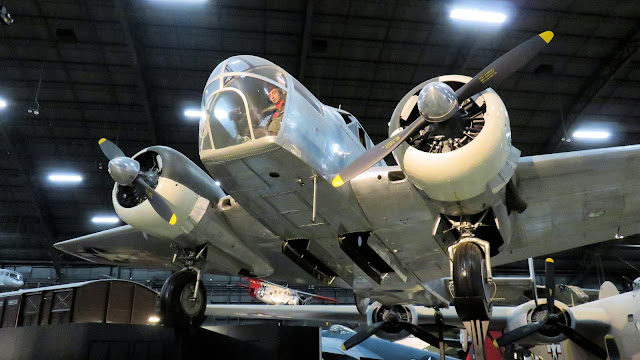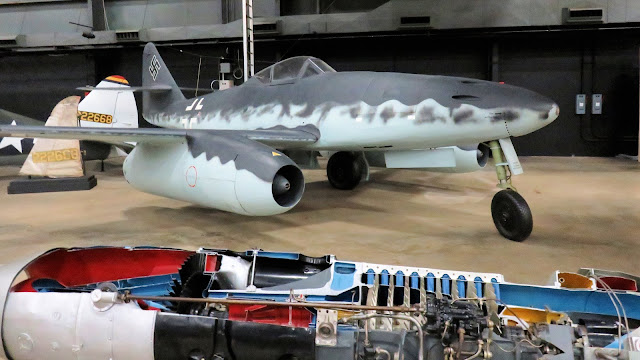National Museum of the United States Air Force
When driving around greater Dayton, OH, observation of an F-104 Starfighter on a stick is a sure sign that the National Museum of the United States Air Force is near.
After some bagel sandwiches for breakfast at the hotel (some assembly required), we arrived at the museum just in time for opening. Bogdan hailed an Uber and met us there.
We did not explore much of the Memorial Park, but I was taken by this sculpture depicting a missing man formation. This cursory exploration set a precedent for exploring the rest of the facility. We spent seven hours at the museum and really only absorbed the Cliff's Notes version. The museum is vast and there is so much to learn there.
 |
| Jason, Gilead, Dan, Bogdan, and me at the National Museum of the USAF! |
The Williamson Flying Club finally made it to the National Museum of the USAF! There were some who said it couldn't be done.
I visit a lot of aviation museums. What excited me most about the Air Force museum was the number of aircraft on display that I have not previously seen or even heard of before. Many are rare or one of a kind specimens. The collection is simply amazing.
Early Years Gallery
The USAF's chronological(ish) display of aircraft starts by leveraging home town advantage with a 1909 Wright Military Flyer.
Up above flies a Bleriot XI monoplane of the type famous for being the first aircraft to fly across the English Channel. This particular example was built from factory plans by an Ohioan named Ernest Hall in 1911. Hall may have been a prolific builder of Bleriot XIs because another Bleriot of the same vintage bears his name at the New England Air Museum.
The Standard J-1 was a slightly shrunken knock-off of the famous Curtiss JN-4 "Jenny" that taught many World War I pilots to fly. Unlike the Curtiss OX-5 powering the Jenny, the Hall-Scott engines installed on the J-1 had an unfortunate habit of bursting into flame. When the bulk of an aircraft is wood and fabric, this is an especially unfortunate design choice.
With all of its fabric removed, this Standard J-1 knows no modesty. Brazen.
Early heavy bombers were little more than open air gondolas strapped to pairs of wings like this late WWI Italian-designed Caproni Ca. 36.
The Martin MB-2 was the first US-designed bomber to be built in significant numbers. It was designed as a WWI era night bomber.
This stubby Boeing P-26A "Peashooter" looks more like a Christmas tree bauble to modern eyes than a serious fighter, but in 1933 it became the US Army Air Corps' first all metal monoplane fighter.
During the interwar period, aircraft transitioned from the wicker and cloth contraptions of the pioneer and WWI periods to designs foreshadowing the shape of things to come in WWII. This example of a Northrup A-17A exemplifies an early template for all-metal monoplanes with enclosed cockpits. The perforated flap design would go on to be very successfully employed by Douglas Dauntless dive bombers. The displayed aircraft is the only one of its type known to still exist.
This display depicts a common training scenario: a North American BT-14 in which the cadet pilot overzealously applied the brakes. If the BT-14 looks familiar, that is because it is essentially an early fixed-gear version of the venerable North American T-6 advanced trainer.
Another plane that I never knew existed is the 1934 North American O-47B observation aircraft equipped with belly windows to allow the crew a view of the world unfettered by wings.
World War II Gallery
The Seversky P-35 was the US Army Air Corps' first all metal, low wing, retractable gear, enclosed cockpit pursuit aircraft. It was not an extraordinarily successful fighter due to a lack of self-sealing fuel tanks, but it ultimately led to the company's highly successful P-47 Thunderbolt (after a corporate name change to Republic). Note the closely-fit wheel fairings integrated onto the landing gear. This is the only known surviving example of a P-35.
 |
| Aeronca L3-B "Grasshopper" |
Based on the DC-2, the incredibly odd-looking Douglas B-18 Bolo served as a front line bomber in the early days of WWII until it was replaced by more effective aircraft like the famous Boeing B-17 Flying Fortress.
The Japanese Mitsubishi A6M2 Zero was once the scourge of the Pacific, despite lacking pilot protections such as armor and self-sealing fuel tanks. The design eschewed these features with a goal of reducing weight in compensation for an underpowered 940 HP engine. As US aircraft became faster, better armored, and equipped with more firepower (i.e., the Grumman Hellcat), the Zero's superiority dwindled.
This North American B-25B medium bomber depicts the aircraft as secured to the carrier deck of the USS Hornet in preparation for the famous Doolittle Raid of April 18, 1942.
The bulbous Curtiss AT-9 Jeep/Fledgling was a multiengine trainer for US Army Air Corps pilots. It was reputedly difficult to land, thus making it an outstanding trainer.
The Bell P-39 Airacobra was one of the more unusual pursuit aircraft of the era. Designed around a 37 mm canon concentric with the propeller spinner, the airplane's Allison 1710 powerplant had to be placed midship behind the pilot with a long driveshaft that ran beneath the cockpit.
While I was already very familiar with the Airacobra from my time at the Air Zoo, I greatly appreciated this display of how the engine, driveshaft, canon, and propeller were configured.
A modified Beech 18, the Beech AT-11 Kansan trained the vast majority of WWII era bombardiers.
Radar equipped, the British-designed Bristol Beaufighter served the US Army Air Corps as a night fighter until US designs began to emerge. Beaufighter crews were responsible for shooting down more than half of the Luftwaffe bombers assaulting London during the Blitz. This one is appropriately named "Night Mare".
Developed in the mid-1930s, the Macchi MC.200 Saetta was one of the primary aircraft of the Regia Aeronautica (Italian Royal Air Force). This example was captured by the British and toured the US as a propaganda tool to raise war bonds. Before going on display at the museum, it was shipped back to Italy for restoration by its original builder.
In 2020, I had the pleasure of spending some unsupervised time crawling through the Boeing B-17 Memphis Belle at the National Warplane Museum in Geneseo, NY. While that aircraft was an actual B-17, the airplane itself was merely the Hollywood representation of the actual Memphis Belle, the storied B-17 Flying Fortress whose crew became WWII celebrities after completing 25 missions in Europe.
The actual Memphis Belle currently lives in Dayton. From 2005 to 2018, the airplane underwent substantial restoration at the museum before finally going on display.
While I have skewed my selection of pictures toward aircraft that were either unique or new to me, I absolutely had to include the North American P-51D Mustang. I think it is one of the most elegantly beautiful military aircraft ever conceived.
Whenever I see Willy Messerschmidt's Bf 109G, I am amazed by its relatively small tail surfaces. Just compare the vertical stabilizer on the 109 to that of the later P-51 Mustang! The "Bf" designation refers to manufacturer "Bayerische Flugzeugwerke" that was ultimately rebranded as Messerschmidt. The Bf 109 was one of the primary fighters of the Luftwaffe. Built in numbers exceeding 30,000, it is believed to be the most produced fighter aircraft in history.
While the WACO CG-4A glider is not depicted on tow behind the Douglas C-47 as at the Air Zoo, I appreciated that these aircraft were displayed together.
The DeHavilland DH 98 Mosquito was a plywood airplane renowned for its speed and versatility. It was powered by two Rolls Royce Merlin engines, the same engines used so successfully in the Mustang, and reached top speeds of 415 mph. The "Mossie" served as a bomber, fighter, and photoreconnaissance aircraft. Many of these aircraft were built at the London, Ontario facility in Canada that now manufactures Diamond Aircraft.
Much like the Mosquito, the Junkers Ju88D/Trop served multiple roles such as dive bomber, level bomber, night fighter, day interceptor, photographic reconnaissance, tank destroyer and even as an unpiloted missile. This particular one, called the "Baksheesh" was famously turned over to the Allies by a defecting Romanian pilot. It is one of only two complete Ju 88s known to exist with the other one, also captured by the British, on display in the RAF museum.
Most famous for carrying cargo "over the Hump" from India to China, the Curtiss C-46D Commando was an unsung hero of its time.
As shown at the museum, the Commando was a capable and versatile hauler.
As a demonstration of that capability, the aircraft retired from active USAF duty in 1968.
I always thought that the deadly Focke-Wulf Fw 190 had a menacing look about it. This particular aircraft was captured by the Allies for study. Famed aircraft engineer and test pilot Bob Hall based part of the design of the Grumman Bearcat on his learnings from poring over a Fw 190.
The Messerschmidt Me 262A Schwalbe ("Swallow") was the world's first operational jet aircraft. Faster than piston-driven fighters, the innovative 262 may have actually affected the outcome of the war were it not for temperamental engines, lack of trained pilots, and supply chain issues. Only a small fraction of the produced 262s actually made it into combat.
The amphibious Consolidated OA-10 Catalina primarily focused on air-sea rescue work.
The menacing Northrup P-61C Black Widow was the first US purpose-built night fighter. This example is one of four remaining in the world. Other Black Widows in the United States can be found at the Smithsonian National Air and Space Museum (Udvar-Hazy Center) and the Mid-Atlantic Air Museum (Reading, PA) where restoration is nearing completion.
It says something about the size and scope of the USAF museum that one can turn a corner and stumble across something as massive as a Boeing B-29 Superfortress tucked away in a corner.
The gravity of the moment is further increased by the historical significance of the example on display: "Bockscar", the aircraft that dropped the Fat Man nuclear bomb on Nagasaki, Japan. This was the second and final use of a nuclear weapon in history and generally credited with ending the war in the Pacific. Was the outcome worth the cost?
Although the ethics of resorting to a nuclear attack are fraught, there is no denying that this aircraft and the dreadful weapon it carried profoundly changed history. Right or wrong, few things in the museum evoke the kind of thoughts and feelings that Bockscar inspires.
 |
| Photo by Dan. |
The airplane validated my choice of attire, even though I would take some crap for it from a random pub employee later that day. By wearing my Curtiss Electric Propellers shirt from the Glenn Curtiss Museum, I blended right in with my surroundings.
The Early Years and World War II galleries comprise one of the four massive hangars of the museum. With all that we had seen, we were only one quarter of the way through the facility. There were lots of interesting displays about various people, relics, and conflicts, many of which I skimmed past in the interests of time. There will be plenty to read should I ever return.























































I always enjoy the photos and background you provide on the museum excursions. Wish I could have made it out that weekend.
ReplyDeleteThanks! Glad to hear. More to come... And, yeah, I knew it was a long shot when I invited you, but it would have been great to have had you along.
Delete